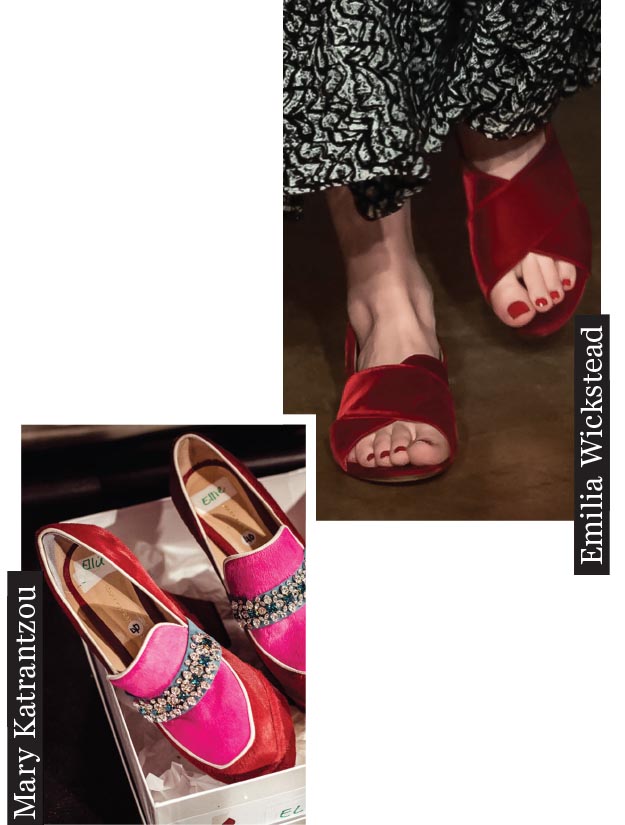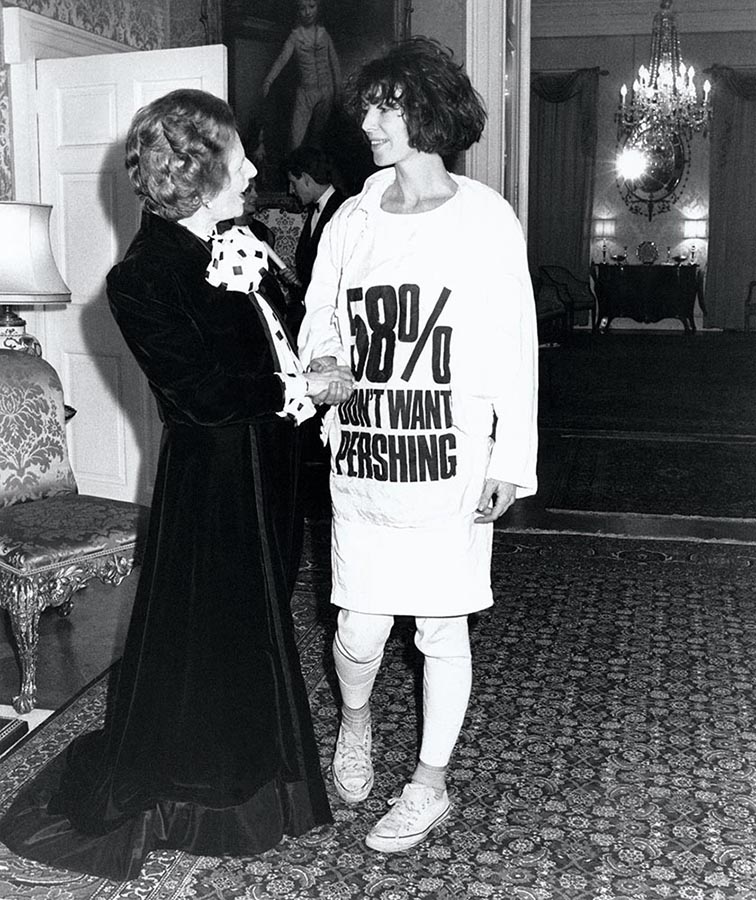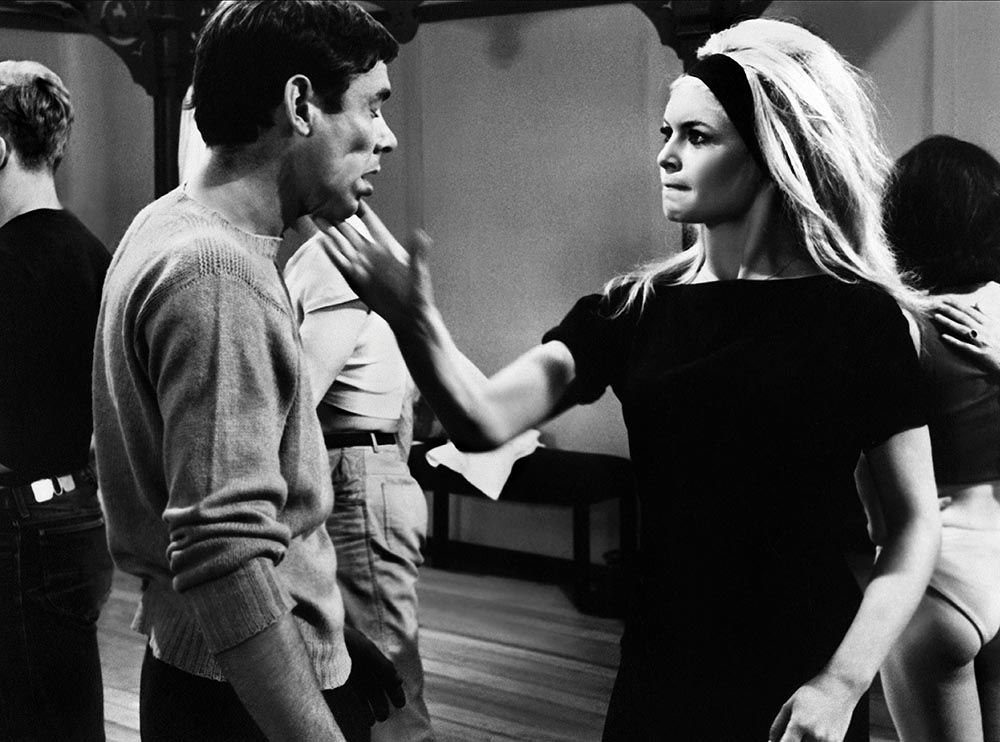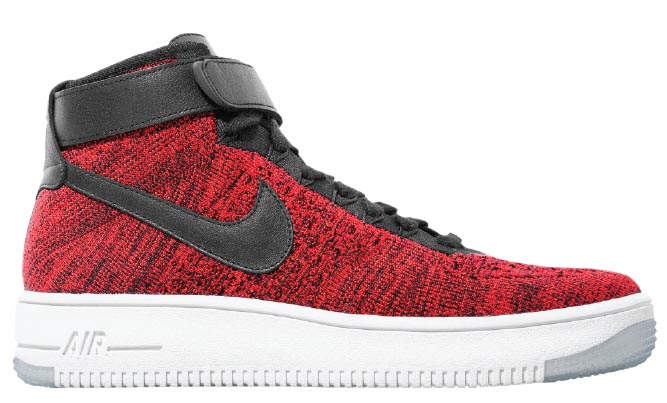
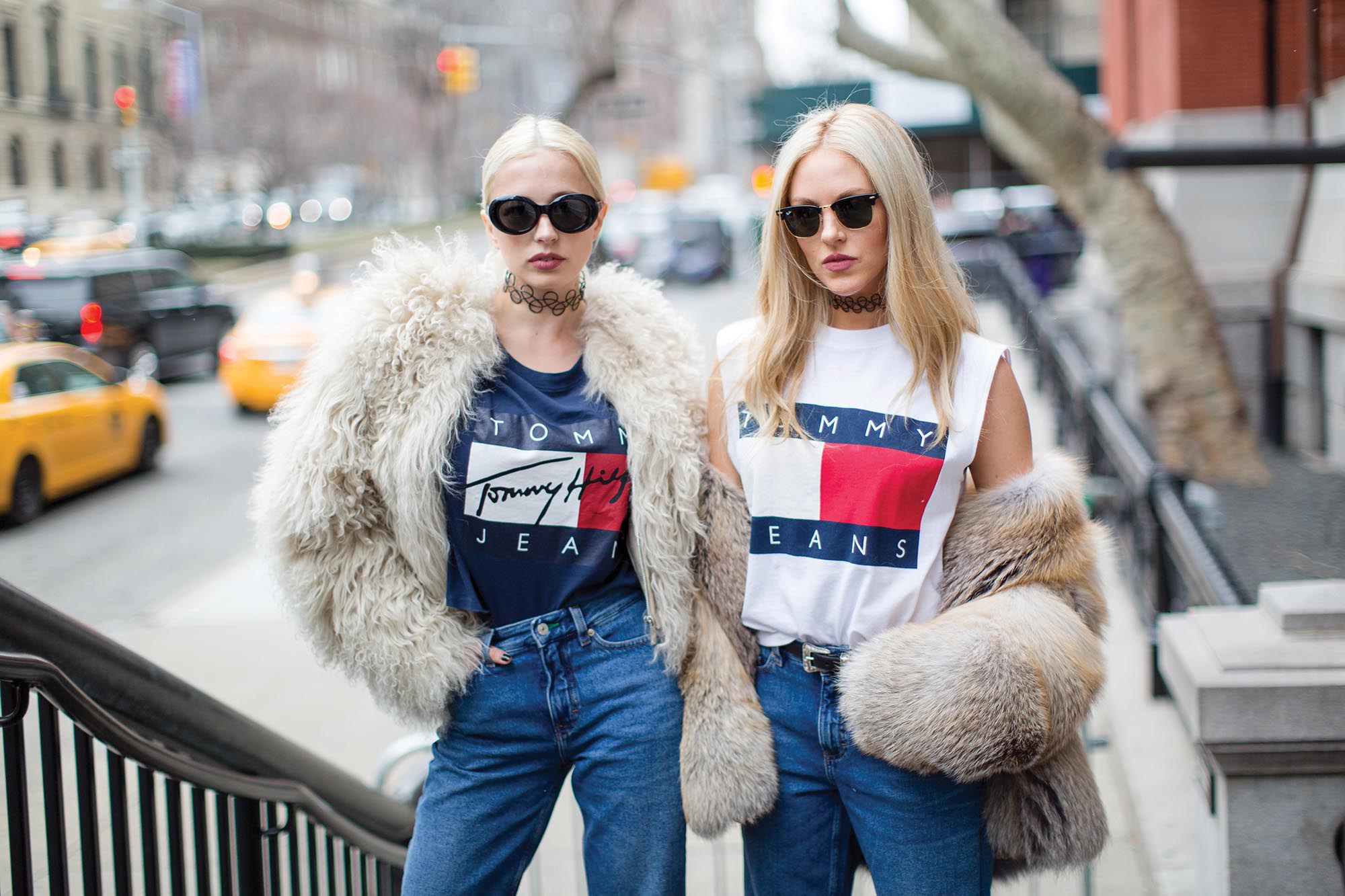








Fashion

Zimmermann
Jump in the water – or don’t – with this sexy, aesthetic Australian swimwear for summer
Zimmermann
Jump in the water – or don’t – with this sexy, aesthetic Australian swimwear for summer
Lifestyle > Fashion |
Zimmermann
June 30, 2017 / by China Daily Lifestyle Premium
If you ever get lost trying to figure out what to wear in summer, go with Australian label Zimmermann. Sisters Simone and Nicky started the namesake label in 1991, based on a line of feminine dresses; it’s now best known for its aesthetic swimwear, in which the same elegance remains. The Summer Swim 2017 collection offers up a range of romantic styles including lace-panel bikinis, fan bralettes and embroidered one-pieces. Get ready to sizzle. (zimmermannwear.com)
![]()
Images: Zimmermann
Back to top

Whatʼs in a Name
In the 1980s, fashion brands began putting their logos on everything. Here, we chart their recent rise to prominence
Whatʼs in a Name
In the 1980s, fashion brands began putting their logos on everything. Here, we chart their recent rise to prominence
Lifestyle > Fashion |
Whatʼs in a Name
May 26, 2017 / by China Daily Lifestyle Premium
Images above: Caroline Vreeland and Shea Marie wear Tommy Hilfiger for autumn 2016
“Gradually, the logo was transformed from an ostentatious affection to an active fashion accessory. Most significantly, the logo itself was growing in size, ballooning from a three-quarter-inch emblem into a chest-sized marque.”
Desperately Seeking Susan (1985) poster
3. Calvin Klein Body underwear, as worn by model Garrett Neff in 2008
Before ready-to-wear became standard practice, made-to-measure was a common choice when it came to getting a piece of clothing. In the 1950s, it became popular among Parisian women to collect sewing patterns – the garment template released periodically in magazines – so they could bring the pattern to a tailor’s shop or sew it themselves at home.
However, self-sewn clothes had all but disappeared by the 1980s as ostentatious, showy styles took the lead. Attire became highly conspicuous, such as Madonna’s garish look in the 1985 film Desperately Seeking Susan, Joan Collins’s powerful woman’s shoulder pads and the yuppies’ preppy upscale styling that rose in parallel with the increase of wealth in many societies including the US, Britain and Hong Kong.
People seemed to be splashing heaps of cash on clothes and desired more visibility. Fashion companies smelled a business opportunity to increase their value by elevating their brand profiles, so they spent enormously on marketing and ad campaigns. Logos evolved from a differentiating name to a strong branding force and a status symbol.
From the decadent ’80s to today, fashion brands have embraced marketing with glamour and creativity, putting their logos under the spotlight. Eminent players in the ’80s and ’90s included emerging American jeans brands such as Jordache, Calvin Klein and Guess, which put their distinctive logos on the back pocket. Traditional French fashion houses such as Chanel, Christian Dior and Louis Vuitton have been huge marketers as well, in a quest to be at the top of those consumers’ minds.
In that era, the size of the logo grew, as well as the influence, from runway to off-the-rack. At London Fashion Week in 1996, Tommy Hilfiger famously dressed his models and rapper Treach (from then-prominent American hip-hop group Naughty by Nature) in giant logo T-shirts with the brand’s signature colours, making a big statement for the label, Hilfiger sales nearly hit US$500 million in 1996 – a huge jump from US$107 million in 1992.
Showing off logos became a key point in styling. When Calvin Klein launched its successful underwear campaigns in the early 1990s using topless, well-endowed male models such as Mark Wahlberg for its line of boxers, countless men (and certainly women, too) started to view the logo in a different light. Now it’s possible to see any type of person sporting a Calvin Klein band around their waist, whether it’s a Hollywood star, a plumber or your next-door neighbour.
Today, logos are prominent on the street – think the Nike swoosh, the Gucci double-G, the Chanel interlocking Cs, the Louis Vuitton monogram. Still others are turning to logo-less products, such as those by Japanese lifestyle brand Muji, whose name means “no-brand quality goods”. Either way, whether you love or hate logos, you can be secure that you’re not defined solely by what you wear.
![]()
Images: ©Bruce Weber/©2017 Calvin Klein (Garrett Neff, Calvin Klein Body); Tommy Hilfiger Licensing LLC/Tommy Hilfiger Licensing BV; Louis Vuitton North America, Inc and Louis Vuitton USA Inc; Moschino; Orion Pictures (Desperately Seeking Susan)
Back to top
Moschino womenswear, SS17
A bag from the Louis Vuitton Monogram Colors collection

Convert Me
Want high heels and flats without carrying an extra pair in your handbag? Thanks to technology, you’re in luck – with convertible shoes
Convert Me
Want high heels and flats without carrying an extra pair in your handbag? Thanks to technology, you’re in luck – with convertible shoes
Lifestyle > Fashion |
Convert Me
May 26, 2017 / by China Daily Lifestyle Premium
Sky-high shoes are lovely, but they can also cause a lot of pain after you’ve worn them for some time. One hour, six minutes and 48 seconds, to be exact, according to a 2013 survey conducted by the UK’s College of Podiatry on how long it takes on average for a woman to feel the agony of high heels.
With this in mind, a few brands have started to experiment with the idea of interchangeable heels. Tanya Heath is one the early pioneers who attempted to make the convertible shoes of her dreams come true. Her brand, Tanya Heath Paris, launched in 2012 after three years of working with a team of engineers, shoe designers and technicians. In various colours, styles and heights (ranging from 4.5cm to a towering 8cm), the brand’s heels can also be personalised.
Most importantly, the replacement of the heels on a pair is quite straightforward – just press a button deep in the insole, slide the heel out and, when you slide the other heel in, do it with a bit of force until you hear a click. “Do make sure you hear the click so that you know the heel is safe to walk in,” advises Heath.
“Our love of high and low” is one of the taglines used by another leading convertible shoe brand: Mime et moi, based in Munich. When one pair of shoes can be converted into multiple styles (be they pumps, boots or flats), the sky’s the limit. And if you love to mix and match styles – and heights – you’re sure to get the best of both worlds.
For footwear aficionados, with all these new choices, you might want to start thinking about a new way of sorting your shoe closet. Could you go by heel type? There’s stiletto, trotter, kitten, block, flat… What about by pattern and style? Try metallic, all-day basic, velvet, mosaic, polka dot, animal print… the list goes on and it’s a brave new world.
![]()
Images: Instagram: @mimeetmoi; @tanyaheathparisfrance
Back to top

Matty Bovan
The up-and-coming designer from London delivers an explosion of colour and texture
Matty Bovan
The up-and-coming designer from London delivers an explosion of colour and texture
Lifestyle > Fashion |
Matty Bovan
May 26, 2017 / by China Daily Lifestyle Premium
Fashion East is a non-profit initiative established in 2000 that aims to nurture young fashion design talent in the early stages of their careers. Each season, it grants three womenswear and three menswear designers a runway presence for their collections during London Fashion Week; for SS17, Matty Bovan was selected for womenswear. The Central Saint Martins graduate, who received the 2015 LVMH Graduate Prize, named his collection Oh Myth. By mixing and matching a wealth of vibrant colours with rough textures, the designer has curated his creative interpretation of a modern myth.(fashioneast.co.uk)
![]()
Images: Matty Bovan at Fashion East
Back to top

Between Worlds
Japanese designer Rei Kawakubo’s singular view of fashion is finally getting the mass recognition it so richly deserves
Between Worlds
Japanese designer Rei Kawakubo’s singular view of fashion is finally getting the mass recognition it so richly deserves
Lifestyle > Fashion |
Between Worlds
April 28, 2017 / by Sonia Altshuler
Rei Kawakubo clearly isn’t Miuccia Prada, but in the countercultural ecosystem of fashion for the disenfranchised, the two bear remarkable similarities. Geography has seemingly dictated the impact of both. Prada has been subject to an A to Z of academic rigour across the fashion campuses of Europe and America, and she been the subject of a Metropolitan Museum exhibition herself in tandem with Elsa Schiaparelli.
But Kawakubo, the creator of Tokyo-based Comme des Garçons (“like boys”), which has grown into a business that churns more than US$220 million a year, has remained largely the preserve of the Japanese. She’s also the co-founder of London’s hip Dover Street Market fashion destination, which she founded in 2004 with her husband, Adrian Joffe.
Now, it seems Kawakubo’s global moment is at hand as she gets a five-month-long run at the Metropolitan Museum of Art’s Costume Institute in New York with Art of the In-Between, running until September. It’s the first monographic exhibition of a living designer at the Met since the Yves Saint Laurent show in 1983.
Prada basically epitomises “ugly chic” in the world today, through her use of fabrics that challenged notions of luxury coupled with provocative designs, but Kawakubo was doing the same several years earlier (at least as far as the West was concerned) when she made her Paris debut in 1981. Kawakubo’s early collections established an unsettling zone of ambiguity that challenged the accepted notions of beauty, good taste, and even fashionability.
One of the first designers to truly challenge the notions of classic tailoring, Kawakubo’s cri de cœur has become deconstruction, bias cuts and all sorts of experiments in shape, seams and asymmetry – much of it gender-bending, such as men’s buttoning on an assortment of women’s garments.
Read More
“Since her Paris debut in 1981, Rei has consistently defined and redefined the aesthetics of our time,” remarked Andrew Bolton, curator of the Kawakubo exhibition at the Met, at a press conference to announce the upcoming show. “Season after season, she changes our eye by upending the received notions of conventional beauty and by disrupting the defining characteristics of the fashionable body.”
For Kawakubo, clothes seem to be her mode of expression on an endless search for newness and originality. Speaking about her spring/summer 2014 collection, she said in a 2013 interview with System magazine: “I tried to look at everything I look at in a different way. I thought a way to do this was to start out with the intention of not even trying to make clothes. I tried to think and feel and see as if I wasn’t making clothes.”
Kawakubo didn’t study fashion, but art and literature, at Keio University. Her first job was at a textiles factory in 1967, which led to her becoming a freelance stylist. Two years later, Comme des Garçons was born, but it wasn’t until 1975 that she opened her first store in Tokyo, by which time the Japanese press referred to her tribal followers as “the crows”. She soon inspired the likes of Martin Margiela, Ann Demeulemeester and Dries Van Noten, and helped launch the careers of Junya Watanabe, Tao Kurihara and Chisato Abe. But the fashion mainstream in the West never really got to know her. Many attribute Prada’s success to Miuccia’s ability to bridge the gap between anti-fashion and commercial high fashion.
Miuccia Prada is candid about Kawakubo’s economically discreet impact on global fashion culture. “I always say ‘Thank God Rei doesn’t want to be commercial’,” Prada said in a 2016 interview with 10 Magazine. “Otherwise, we would all be dead.”
It’s precisely Kawakubo’s market-insensitive approach that defines her singularity. “If, as Andy Warhol proposed, ‘Business art is the step after art,’ Rei is its fashion manifestation,” remarked Bolton. “It’s within this elastic zone between fashion and commerce that Rei’s ‘art of the in-between’ occupies and most powerfully expresses itself.”
The closest Kawakubo ever came to outright commerciality was collaborating with Swedish retail giant H&M in 2008. “I have always been interested, as an independent businesswoman, in the balance between creation, which is the core value of Comme des Garçons, and good business, which comes a close second,” Kawakubo told this reporter that year. “Comme des Garçons with H&M is the epitome of this challenge.”
Margareta van den Bosch, creative director at H&M (which is sponsoring the exhibition, along with Apple, Farfetch and Valentino) said that Kawakubo had been atop their wishlist for design collaborators from the start. “She’s always been at the forefront, experimenting with garments, never following any rules. We have tremendous respect for Kawakubo’s fashion philosophy, which questions the entire fashion world’s ingrained patterns.”
One simple mantra may explain what has evolved: “It’s easier to break the rules if you haven’t learned them,” Kawakubo told this reporter a decade ago. At the time of the collaboration with H&M, she was pre-empting millennial-speak: “There is more and more demand for independent points of view because not everyone wants to be the same as everyone else. Ultimately, people like to be free and independent, if given half the chance.”
And in a world full of electronic excitation and daily digital onslaught, Kawakubo’s retraction from culture is a plus. For someone so present in terms of influence, she’s aesthetically and commercially absent. “Going around museums and galleries, seeing films, talking to people, seeing new shops, looking at silly magazines, taking an interest in the activities of people in the street, looking at art, travelling: all these things are not useful, all these things do not help me, do not give me any direct stimulation to help my search for something new. And neither does fashion history. The reason for that is that all these things above already exist,” she said in the 2013 System interview. “I only can wait for the chance for something completely new to be born within myself.”
Kawakubo makes for an inspiring figure and, for many, an epiphany. “There is no right or wrong way,” she said in an interview with this reporter. “Comme des Garçons is always looking for new ways to express its values, which are based around creating new ideas and making strong, creative clothes.” Visit the Met’s Costume Institute and marvel at the below-the-radar output of a woman whose work may be timeless, but whose moment of recognition – while more than welcome – is happening at least a decade too late. ![]()

Code Red
With the release of Pantone’s latest colour guide, you’d better get ready for a blazing-hot autumn
Code Red
With the release of Pantone’s latest colour guide, you’d better get ready for a blazing-hot autumn
Lifestyle > Fashion |
Time to Shine
April 28, 2017 / by China Daily
Pantone is the New-Jersey based corporation best known for its Pantone Matching System, which standardises colours in a fan-format book. It was originally developed by founder Lawrence Herbert in 1963 as a tool for graphic designers to communicate colours more easily in the printing process.
Through the Pantone Color Institute, Pantone forecasts up-and-coming colour trends as well as various colour solutions for companies to meet their branding needs. Since 2000, the institute has selected its “Colour of the Year” by researching industries across the realms of fashion, art, film, technology and automobiles. The colour of 2017 has been named Greenery, a revitalising yellow-green shade that’s symbolic of nature and new lives.
Pantone also releases its bi-annual Fashion Colour Report for each spring and autumn, launched in conjunction with New York Fashion Week – and for the first time this year, London Fashion Week has been added – to highlight the company’s top 10 colours it’s forecasting for the upcoming season.
If looks are anything to go by, this autumn’s palette is certainly going to be eye-catching. Just look at the leading colours: Grenadine and Flame Scarlet. They’re set to rock your wardrobe this autumn, so get ready to dress to impress.![]()
Spotted at New York Fashion Week for A/W 2017, Grenadine is pure pomegranate syrup; this colour of passion and sweetness will serve not only your cocktail, but also your pretty autumn garments. Intoxicated by a slightly orange-ish tone, this one is more crystalline than royal red and warmer than scarlet.
Half or Partial
Pair this statement-making reddish hue with a simple T-shirt or a challenging leopard print – and see how far you’d like to take the look.
Power Set
Dress in the same colour tone from head to toe, but mix different textures – from liquid lamé to wool, calf and leather. The luxurious profile needn’t be understated this autumn.
Read More
Spotted at London Fashion Week for A/W 2017, this one is as vivid and exciting as it reads. More audacious than Grenadine, Flame Scarlet is an intensified reddish-orange.
Eyes Down
Keep the above-the-feet area in neutral colour tones so those statement shoes can truly become the spice of your ensemble.
Walking Flamboyance
The ultimate dress-to-impress code – just be careful not get everyone too hot under the collar.
Touch of Fur
When fur and this flaming colour get together, expect double the impact.
Images: Pantone LLC; Oscar de la Renta; Max Mara S.r.l./Max Mara Group; Adam Selman; Kate Spade; Emilia Wickstead; Mary Katrantzou; Amanda Wakeley; Christopher Kane
Back to top

Revolutionary Road
Over the course of several decades, the T-shirt has risen from a humble workwear garment to a worldwide wardrobe staple for everyone
Revolutionary Road
Over the course of several decades, the T-shirt has risen from a humble workwear garment to a worldwide wardrobe staple for everyone
Lifestyle > Fashion |
Revolutionary Road
April 28, 2017 / by China Daily
The film poster for Whirlpool (1959)
In the finale of Prabal Gurung’s autumn 2017 fashion show, the designer and his models startled the audience with their T-shirts, stamped with provocative political slogans such as: “The future is female.” “I am an immigrant.” “This is what a feminist looks like.” Clean-cut white T-shirts have become the perfect means for fashion designers to convey a blunt message – and they’re easy to match with just about anything in your closet.
Evolving from the late 19th century when the one-piece garment was divided in two for miners and others working in hot environments, the history of the T-shirt took shape in the early 1900s when the US Navy began issuing the white, form-fitting, crew-neck cotton undergarments. First attributed in print to F Scott Fitzgerald in his debut 1920 novel This Side of Paradise, the T-shirt served as an unofficial uniform for labourers in the US, from farmers to factory workers – yet it wasn’t considered fashionable at all until the 1940s, when it became popular among teenagers.
When Marlon Brando wore his tight-fitting white T-shirt in A Streetcar Named Desire in 1951, the whole world began to discover the hidden sexiness under the soft cotton. T-shirts became associated with masculinity and confidence. The 1955 film Rebel without a Cause, with James Dean, further pushed the T-shirt’s “bad-boy” image, with Dean’s iconic white T-shirt paired with a red nylon jacket and light-blue jeans. With comfort, inexpensiveness and style rolled into one, T-shirts became a man’s wardrobe staple.
Slightly after the craze hit the men’s scene, the T-shirt was also earning feminine power through elegant silhouettes on French screens. Juliette Gréco interpreted the woman-on-the-go image in the 1959 film Whirlpool with various T-shirt styles; on the movie’s poster, she’s in a fitted black V-neck T-shirt, with her unruly facial expression adding to the garment’s status as a rebellious symbol.
Read More
The famed I Love NY T-shirt
In the 1962 film A Very Private Affair, Brigitte Bardot also contributed to the look with a short-sleeved, black boat-neck T-shirt, leaving a lasting impression, particularly in the scene when she slaps Dirk Sanders.
Fruit of the Loom is one of the oldest US garment manufacturers still active in the business today; it was founded in 1851 in Rhode Island as a quality cotton cloth and textiles producer. Later, the company expanded from nightshirts and underwear into classic mono-colour T-shirts. Graphic T-shirts came into the public attention around the 1950s, when Miami-based company Tropix Togs acquired the exclusive rights from Disney to print images of Mickey Mouse and holiday resort names on its T-shirts.
A couple of decades later, the famed “I ![]() ™ New York” T-shirt was unveiled to the world. The original logo was by famed graphic designer Milton Glaser, who created it for the New York State Tourism Department in 1977 for free, not knowing that it would linger for years and inspire numerous cities to follow suit. It’s estimated that New York State lawyers have filed more than 3,000 objections related to violations of its trademark.
™ New York” T-shirt was unveiled to the world. The original logo was by famed graphic designer Milton Glaser, who created it for the New York State Tourism Department in 1977 for free, not knowing that it would linger for years and inspire numerous cities to follow suit. It’s estimated that New York State lawyers have filed more than 3,000 objections related to violations of its trademark.
Be it plain comfortable or effortlessly sexy, a classic rock concert memory or everyone’s favourite tourist souvenir, a harmless fashion triviality or a powerful political statement, the T-shirt remains an essential piece in everyone’s wardrobe.![]()
Image: The Rank Organisation/J. Arthur Rank Film Distributors (Whirlpool); Compagnia Cinematografica Montoro (CCM), Compagnie Internationale de Productions Cinématographiques (CIPRA), Progéfi, AF archive/Alamy Stock Photo (Dirk Sanders & Brigitte Bardot); The New York State Department of Economic Development (I Love NY T-shirts); Katharine Hamnett (Katharine Hamnett meets Margaret Thatcher); Twitter: @zaynmalik (Gigi Hadid); Instagram: @houseofholland (Kendall Jenner)
Back to top

The Rise of Sneaker Culture
Sneakers have evolved over time from functional sportswear to top status symbols
The Rise of Sneaker Culture
Sneakers have evolved over time from functional sportswear to top status symbols
Lifestyle > Fashion |
The Rise of Sneaker Culture
April 28, 2017 / by China Daily
Fe Lo Classic White, Feiyue
According to the Census and Statistics Department of Hong Kong, the retail sales of sneakers in the city reached HK$436.6 billion last year. The dynamic Mong Kok shopping district has opened its arms to thousands of visitors every day, maps in hand as many try to locate “Sneakers Street” (on Fa Yuen Street) in this densely packed area.
Chuck Taylor All Star Sloane, Converse
Meanwhile, on Instagram, the popular sneaker-related hashtag #yeezy continues to run the show, with more than five million mentions. It started in 2009, when hip-hop artist Kanye West launched his sneaker collection with Louis Vuitton, then the Air Yeezy with Nike the same year, followed by the Air Yeezy 2 in 2012. However, in 2015, he switched over to Adidas and introduced the Yeezy Boost 750 and 350, both unquestionably the most-wanted kicks among “sneakerheads” (avid collectors) that year – and they’re still highly sought after. The former was limited to 9,000 pairs worldwide and sold out in 10 minutes.
The first “sneakers” (though they weren’t named that yet) debuted in the 1860s. Made of leather and spikes, they were introduced as the first specialised running shoes by British company Thomas Dutton and Thorowgood. In 1892, the US Rubber Company introduced a pair of rubber shoes with canvas tops called Keds. The company mass-produced them in 1916 and an advertising agent nicknamed them “sneakers” to suggest how quiet they were due to their rubber soles.
In 1917, the Converse Rubber Shoe Company introduced the prototype of the All Star; the famous name wasn’t adopted until basketball player Chuck Taylor became aligned with the brand. He joined the Converse sales force in 1921, then became a player and coach for the company’s basketball team, the Converse All Stars. Taylor saw his name added to the ankle patch, which he had helped develop for better support, and the shoe ultimately named for him as a token of appreciation. In the 1960s, some 90% of university and professional basketball players in the US wore the Converse Chuck Taylor All Stars. Confused about the big difference between sneakers and trainers? Many use the terms interchangeably, but there actually is a difference; the former are athletic-based shoes and are usually worn more for fashion, while the latter are named as a short form for “training shoes” and are aimed at improving performance in a specific athletic activity, such as running or weightlifting.
Read More
Aside from Kanye West, top fashion designers have also collaborated with sports brands to present collections as sneakers move into the world of high fashion. As an example, for autumn 2016, Raf Simons released his reinterpretation of Adidas’ iconic Stan Smith sneakers; the classic “three stripes” on the side were replaced with the designer’s perforated “R” logo and a more luxurious, minimalist approach. Also with Adidas, Stella McCartney has been designing sneakers, trainers and other gym wear for women since 2005.
Founded in Shanghai in the 1920s, the nostalgic martial arts-suitable shoe brand Feiyue flew across Chinese borders in 2006 (its name, indeed, means “flying forward”) and landed in France. Whether it was or wasn’t officially licenced, its unique retro style, coupled with a fresh French redesign, caught the eyes of Europe and launched a new obsession that was unprecedented in China.
The present-day sneaker culture has evolved to combine not only athletics and fashion, but also the omnipresent marketing and business angles. For most sneakerheads, it’s about the hardest-to-find pairs. Since the 1980s, they’ve come to Mong Kok from all over the world to source sought-after shoes at low-tax prices. Fanatics camp out for rare new releases, while others buy through resellers, sometimes paying 10 times or more compared to the retail price.
Globally, limited-edition sneakers are a definite status symbol for those who are willing to pay. One high-end sneaker reseller in Los Angeles shared his recent deals, which included the sale of a pair of Nike Air Jordan 4 Retro “Eminem Encore” for US$30,000 – only 50 pairs were made at an original retail price of US$180.
A Beijing-based sneakerhead who regularly shops for limited editions, Tianyi recalled the first time he started to save up for a pair of Adidas T-Macs (named for basketball star Tracy McGrady) when he was 13 years old. This was 10 years ago and he was the only kid in school with the shoes’ iconic black and red design. From that moment, he became fascinated by the irreplaceable thrill of standing out from his peers.
However, in the past decade, things have changed. “Now, when you visit a middle or high school in Beijing, you see a bunch of boys wearing Yeezy,” he says. “It’s definitely a scene now.” No matter whether as a wardrobe staple or a status symbol, sneakers have become truly essential – put your best foot forward. ![]()
Yeezy Boost 350, Adidas
Kyujo High, Y-3
Air Force 1 Ultra Flyknit, Nike
Air Jordan 4 Retro “Eminem Encore”, Nike

Supreme
The streetwear kings bring some serious heat to the urban jungle
Supreme
The streetwear kings bring some serious heat to the urban jungle
Lifestyle > Fashion |
Supreme
March 31, 2017 / by China Daily
Get ready to brave the concrete jungle in proper style with the latest Supreme collection, full of vibrant elements and imbued with the brand’s encapsulation of all things urban. Military camouflage, leopard-patterned jackets, Native American tribal motifs, striking colour-contrast vibes and multi-printed trousers – everything’s an essential addition to your streetwear wardrobe.
![]()
Images: Supreme
Back to top

Michael Bastian
The acclaimed designer saw fit to jazz up this season’s runway
Michael Bastian
The acclaimed designer saw fit to jazz up this season’s runway
Lifestyle > Fashion |
Michael Bastian
March 31, 2017 / by China Daily
This spring, Michael Bastian is opening your eyes and your ears. Designed in New York and made in Italy, the jazz-inspired collection pays homage to American jazz greats such as Miles Davis, John Coltrane and Herbie Hancock. Between the music notes, you’ll also find a sporty tempo and the casual-classic by way of track jackets and double-breasted suits, all delivered in a range of luxurious materials.
![]()


















